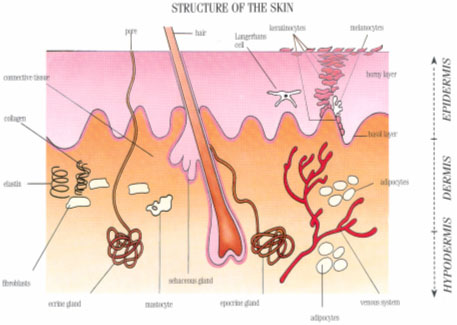 |
 |
 |
 |

|
From its inception, our vision at
Bellini has been to provide the highest quality, natural
professional bodycare products available using the purest
botanical extracts, essential oils, and naturally-derived
ingredients.
Discerning consumers are aware that many
cosmetics and �natural� products on the market contain
ingredients that have well-recognized health hazards
associated with their use; at Bellini, we offer
moisturizing, rejuvenating plant extracts and nutrients
that cleanse, rehydrate and revitalise the skin naturally,
without harsh chemicals, artificial fragrances or colour,
or synthetic preservatives. |
 |
BOTANICALS
Over the millennia, indigenous cultures the world
over have utilised plants in multitudinous ways: food,
shelter, clothing, medicine, and ceremonial purposes are
but some of the many ways that plants have come to be
used. Their life-giving properties have been honoured
and revered and, even today, the majority of the world�s
population uses traditional botanical medicine as their
primary form of healthcare. When one considers the
diversity of applications that plants provide for, it is
easy to understand their increasing importance and
usefulness in any healthy lifestyle.
Over the last few decades, the medicinal and cosmetic
virtues of plants have become more widely appreciated
and utilised in the �developed� world as well. Their
many active principles are buffered within a vast
complex of constituents that synergistically compose the
entire plant. This important feature diminishes the
likelihood of adverse reactions to a single component
and, because of their inherent harmony with our own
biological processes, plant extracts are easily
recognised by the body�s established metabolic pathways,
ensuring maximal bioavailability without additional
stress on the body.
ESSENTIAL OILS
Amongst the thousands of individual constituents
contained within each plant are its essential oils,
volatile byproducts of cellular metabolism. Essential
oils are composed of a complex mixture of principles and
are produced and stored within the plant in specialized
cells: glands, glandular hair, glandular scales, oil
cells, hair cells, oil and resin ducts, and oil
containers. They play an important role within the plant
(e.g., attraction for pollination purposes; protection
from predators or infections) and also provide for many
therapeutic applications, both medicinally and
cosmetically. Their unique chemical structures lend
themselves to transdermal applications exceptionally
well, crossing the protective lipid of the epidermis to
affect local sites as well as being absorbed into the
circulation for systemic distribution.
THE SKIN
A healthy, intact skin barrier provides us protection
from the environment (chemical and physical elements)
and is our first line of defense against invading
micro-organisms. It is our largest organ (surface area
approx. 1.5 m2) and is made up of a surface epithelial
layer (the epidermis and dermis) and an underlying
connective tissue network called the hypodermis (or
subcutaneous connective tissue layer) that stores
adipose tissue and provides support and flexibility.

The skin�s main functions include:
A. EPITHELIUM
The epithelial layer is made up of two regions:
Epidermis
Dermis
1. EPIDERMIS
The epidermis is the most superficial layer of the skin
and provides the first barrier of protection from
invasion of foreign substances into the body. It does
not contain any blood vessels, though it does contain
nerves and outlets for glandular secretions (sebum,
sweat.) The deeper layers of living cells in the
epidermis receive their nutrition from blood vessels
located in the underlying dermis.
The epidermis is composed of five layers:
stratum corneum
stratum lucidum
stratum granulosum
stratum spinosum
stratum germinativum
1. Stratum corneum:
-
most superficial skin layer
-
provides barrier against the external
environment
-
lipid layer of stratum corneum is
responsible for barrier impermeability towards most
substances; also utilised for enhancing transdermal
permeability of skin
-
comprised of tightly packed,
scale-like cells (keratinocytes) that have developed a
thickened keratin (protein) layer
-
keratinocytes migrate towards the
surface and are constantly being sloughed off in a
process called desquamation
2. Stratum lucidum:
-
between stratum corneum and stratum
granulosum
-
contains degenerating cells which have
lost their nucleus
-
cells here are losing water and
producing increased amounts of keratin as they move
towards the stratum corneum
3. Stratum granulosum:
-
formed by many layers of living cells
-
contains pigments that determine skin
colour
-
fits tightly on dermis
-
new cells always forming and moving
outwards towards the stratum lucidum
-
takes at least one month for the cells
to reach the surface and be exfoliated
4. Stratum spinosum
5. Stratum germinativum
2. DERMIS
The dermis lays beneath the epidermis and is composed of
two layers:
Papillary Layer
Deep Layer
1. Papillary Layer:
-
Contains concentric zones of
protrusions called papillae, visible as �fingerprints�
-
2 types of Papillae:
� Vascular � contain a central lymphatic vessel
surrounded by capillary vessels
� Nervous � contain tactile, sensory nervous
tissue as well as vessels
2. Deep Layer:
B. SUBCUTANEOUS
LAYER
The subcutaneous layer is made up of three regions:
Panniculus
adiposus
Connective membrane
Subdermal connective tissue
1. Panniculus adiposus
-
Comprised of adipose (fat) tissue
which is distributed over almost entire body surface
-
Thickness of 1 to 4 cm. (increased on
obese person)
-
Provides protection, thermoregulation
and energy reserves
2. Connective membrane
3. Subdermal connective tissue
|
 |
 |
|
Back to Top
 |
|
|

